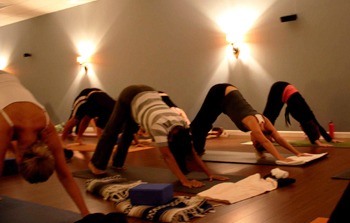Ever catch a glimpse of yourself in the mirror or in a photo and you see “it”?
Back fat.
And then you start battling those years of subliminal messaging and airbrushed magazine photos in your head.
Upon seeing the rolls, you may have worked yourself into a frenzy of limiting, non-supportive thoughts, as we are taught to do in our culture.
You are gorgeous. I want you to know that, and I hope that your yoga practice will always support you in creating your world of body positivity.
However, my focus in writing this isn’t really about addressing body image, but rather the physiological and therapeutic aspects of the “back fat” phenomenon.
So here’s my take: your back fat may actually not be back fat.
As we age our rib cage sinks with gravity, nearing closer to the hip bones. And as a result, we lose a lot of length in our lateral or side bodies, creating the appearance of fat when in actuality, it’s folds of skin that don't know where to go anymore.
In addition, the most mobile part of the spine is located between the bottom ribs and the hips. Because this part of the spine is not hindered by the pelvis or the rib cage it is easy to jam the front ribs forward, collapsing this part of the spine (a.k.a.,your mid section or waistline). This also contributes to the folds of skin on our backs.
So you think you have back fat? You may, and that in and of itself is no big thing. Instead, ask yourself, “How long is my side body? Is my rib cage sitting on my freaking pelvis? And what might that be doing to my posture, my organs, and my respiratory system?”
In other words, we can stop obsessing about how we look and start focusing on freeing up our side body in order to breathe easier and more efficiently, make more space for our organs, and improve our orthopedic longevity!
This isn’t a question of body fat, it’s a question of optimal health!
Sure, a higher percentage of body fat is going to create a larger fold, but before you start looking at your rolls and unnecessarily worrying about your weight, realize that gravity is at play here and that you can hold your ribs for optimal alignment, minimizing the appearance of that supposed "back fat".
Of course, one could reduce body fat percentage and that will help decrease the size of the folds. However, until you embrace these folds as a postural issue, they will stay around until you start doing one simple posture modification.
I call it: “Get bright like a toddler”. And it means:
- Stand up tall.
- Lengthen your sides starting from the top of your hips up to your armpits until your collar bones are square with the base of your neck. Do this without shrugging your shoulders up toward your ears, just lift from within.
- Inflate your mid-section and lift your back ribs up away from your hips.
- Finally, pull your shoulders back (or in anatomical terms, pull the head of the humerus ie. the ball-like head of the arm bone that goes into the shoulder socket) back.
Most fitness experts try to target "back fat" by prescribing back extension exercises such as “superman” where you lay on your stomach on the floor or on a fit ball and lift everything off the floor or ball, thinking this will “tone” the back. Which it will, but this does not address sinking rib cage syndrome or posture problems.
If you look at the picture of the toddler below, you’ll see that her whole torso is bright with breath and energy, her armpits are elevated, and her shoulders are not pulled “down away from her ears”. If anything the head of her arm bones and collar bones are elevated.

And here is the rear view on another little tyke. Notice, no skin folds on his back. The head of his arm bones are square with the base of his neck and from hips to armpits, he has nice length in his side body. His midsection is also full and bright.

I figure if babies and toddlers hold themselves like this so recently out of the womb, they've got something to teach us! When I used to take my baby sister to the playground, I observed that the children 3 and under had this bright posture. It's universal. But by ages 4 and up, their posture started to look more like the grown ups. Hit the playground and see for yourself!
In contrast to the toddlers, the photo of myself below is what I call “dull-like-an-exhausted-adult”. You can't see my face, but I'm hamming it up for the camera and exaggerating the undesirable posture in my body for you.

Notice the head of my arm bones and collar bones drop well below the base of my neck as indicated by the horizontal line and arrows. My side body (distance between my hips and my armpits) is shortened, and energetically my torso is listing downward with little life or energy in it.
Even without this being a profile shot - you might be able to see that my mid section is collapsed. And not surprisingly, my back skin folds are visible.
It would take just those four little postural changes to even out the folds, open up the breath, protect my back, and make more space for my organs. In this photo you can see the transformation when I do that:

Here my side body is lengthened from hips to arm pits as indicated by the arrows, my collar bones are square across with the base of my neck (indicated by the horizontal line), the head of my arm bones are back, and my mid section is full, with front ribs down. Energetically the whole torso is lit up. Skin folds? They vanished.
Side benefit! Your rhomboids, the muscles between your shoulder blades and spine (that help hold your shoulder blades flat on your back), get very strong when you do this. They might be fatigued at first and you may feel a bit stiff, however as you hold your posture this way more and more, your rhomboids will get in shape and the road to permanently awesome posture begins.
Especially as we clock more years on this planet, the “dull-like-an-exhausted-adult” is an easy posture to find yourself in, but I submit, if you can find the inner toddler inside you, your (supposed) “back fat” will go buh-bye and your body systems will thank you!
Give it a try and tell me what you think in the comments below!












